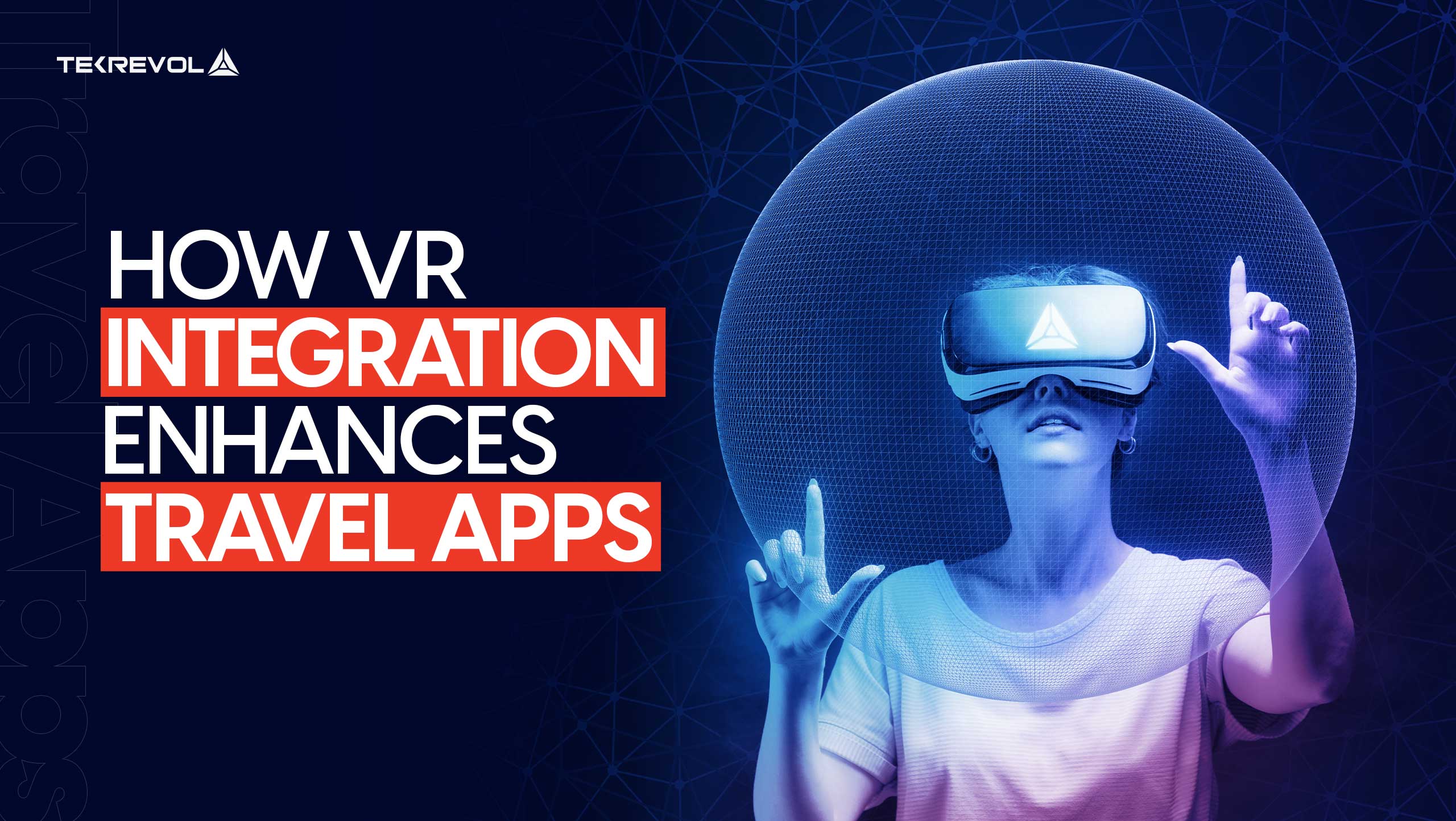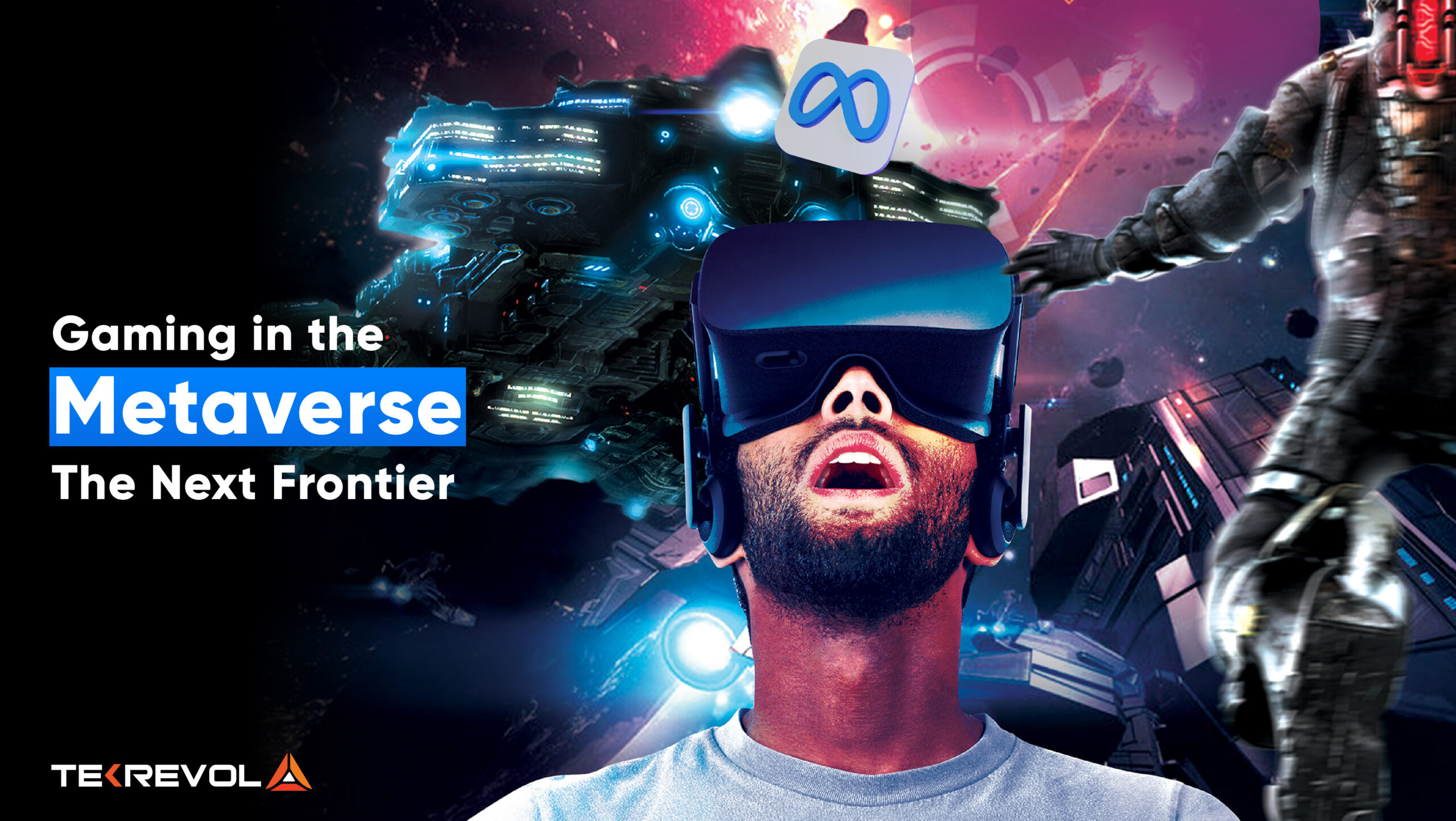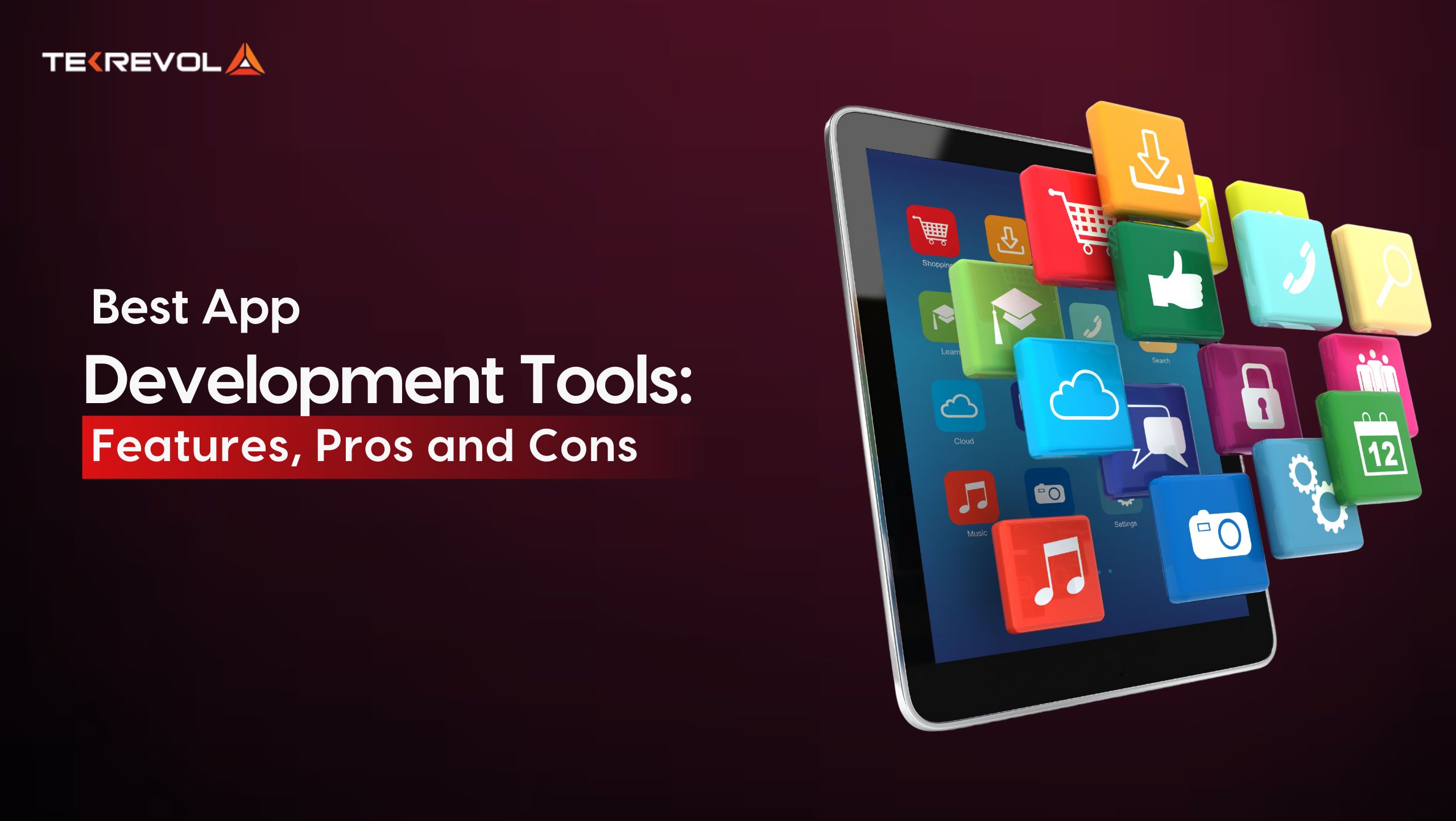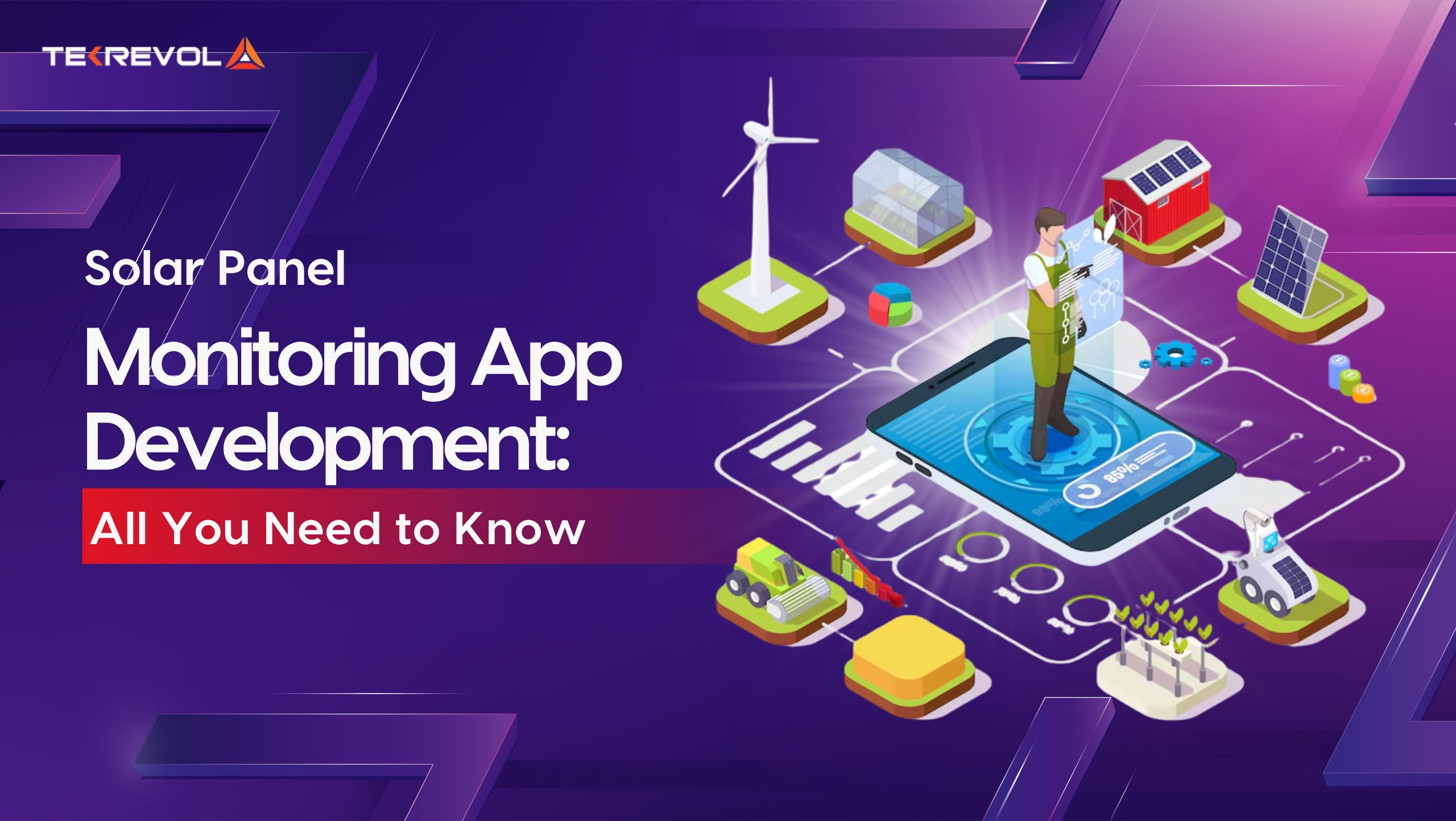Have you ever booked a trip or a hotel room and arrived at the destination only to find it was not what you had expected? There’s always this nagging feeling when one sets down to plan a vacation, that one cannot properly prepare oneself for what is in store, despite the vast amount of information and photographs accessible online.
Here’s where the technology innovation of Virtual Reality (VR) completely changes how we experience travel planning. The global virtual tourism market, valued at $5 billion in 2021, is currently projected to reach $24 billion by 2027, highlighting the increasing significance of VR in the sector.
With its ability to provide realistic virtual representations of places, virtual reality (VR) innovative technology has emerged as a highly important tool for the tourism industry, allowing customers to move from an online search to the real experience.
Having the ability to interact with a virtual representation of hotels, attractions, or locations allows travelers to experience a place in a more realistic and detailed way.
It’s the ideal time for travel companies to integrate virtual reality (VR) into their apps in order to improve client interaction and offer never-before-seen virtual tours of sites.
So, if you have no idea where to go to create compelling virtual experiences that draw in clients and improve their decision-making process, a top-notch VR development company may make all the difference.
If you are still confused and want to hire developers for your project, the USA, being a technical hub of innovation, offers some of the best app developers in San Francisco, Miami, and in other regions. These developers are known for their expertise in creating top-notch VR applications.
So, let’s discuss more about virtual reality (VR) with a quick overview of Augmented reality (AR), and how it is changing the travel industry.
- Have a great VR app idea?
- Our developers can help turn your vision into reality..
What is Augmented Reality (AR) & Virtual Reality (VR)?
Immersive technologies such as Augmented Reality (AR) and Virtual Reality (VR) are technologies that change our perception in some way, but they function in different ways.
Augmented Reality takes information from the physical environment and adds digital information and virtual objects. It usually overlays digital objects in the real-world environment by adding images, videos, or animations which the users can freely interact with. AR experiences are usually seen on devices such as smartphones or AR glasses, which combine the digital and real worlds into one.
On the other hand, users of virtual reality (VR) are fully immersed in a computer-generated environment. Wearing a headset that covers their eyes and ears and substitutes a virtual world for the real one is usually required for users to interact with virtual reality. Controllers and other input devices can be used by users to engage with this virtual world and create the impression that they are physically in the imagined location.
A Statistical Reasoning For VR Adoption
Virtual Reality (VR) is quickly becoming the next big thing in the tourism industry due to increased data on its acceptability and benefits.
Surge in VR Tourism Adoption
Statista reports that VR adoption in tourism increased by 30% in 2024, reflecting a notable increase in the technology’s appeal. This expansion shows that customers are becoming more at ease and curious about virtual travel options.
Integration by Travel Agencies
According to Gartner, half of the world’s travel firms will use virtual reality (VR) for destination showcasing by 2025. This significant move shows that the travel industry recognizes VR as a potent tool for improving client engagement and decision-making.
Rising Consumer Interest
SEMrush says searches for virtual reality travel experiences have increased by 40% in the last year. This indicates that consumers are becoming more curious and demanding immersive travel experiences, which virtual reality can offer uniquely.
The Transformative Impact of Virtual Reality on Travel
While most digital advances happen gradually, the arrival of Virtual Reality (VR) is expected to drastically and has never before been seen in the travel sector. New developments in virtual reality are changing our understanding of accessibility, distance, and tour planning.
The following are a few of the most fascinating developments in virtual reality travel that are changing the game:
VR for Exploration
Imagine never having to leave your home to hike through the breathtaking natural beauty of New Zealand, relax on a stunning beach in the Maldives, or take a stroll through the ancient streets of Rome. These immersive experiences are being created by travel agencies through VR. It helps prospective visitors in researching and exploring many locations before choosing one to visit.
VR For Marketing
Virtual reality is quickly growing as a means of advertising tourism destinations. The production of compelling VR content that is published on tourist websites, travel blogs, videos, and social profiles has the potential to attract a larger audience and improve brand exposure tremendously. Such encounters allow folks who are inclined to visit a location to feel more connected to it.
VR in Hospitality
To give prospective customers realistic sneak peeks into their deals, hotels, and resorts are utilizing virtual reality. Potential guests can virtually explore the facilities, take in beautiful views of the surroundings, and tour the rooms. Booking rates rise as a result of this, which also improves the booking experience and develops excitement and trust.
Top 10 Advantages of VR Integration in Travel Apps
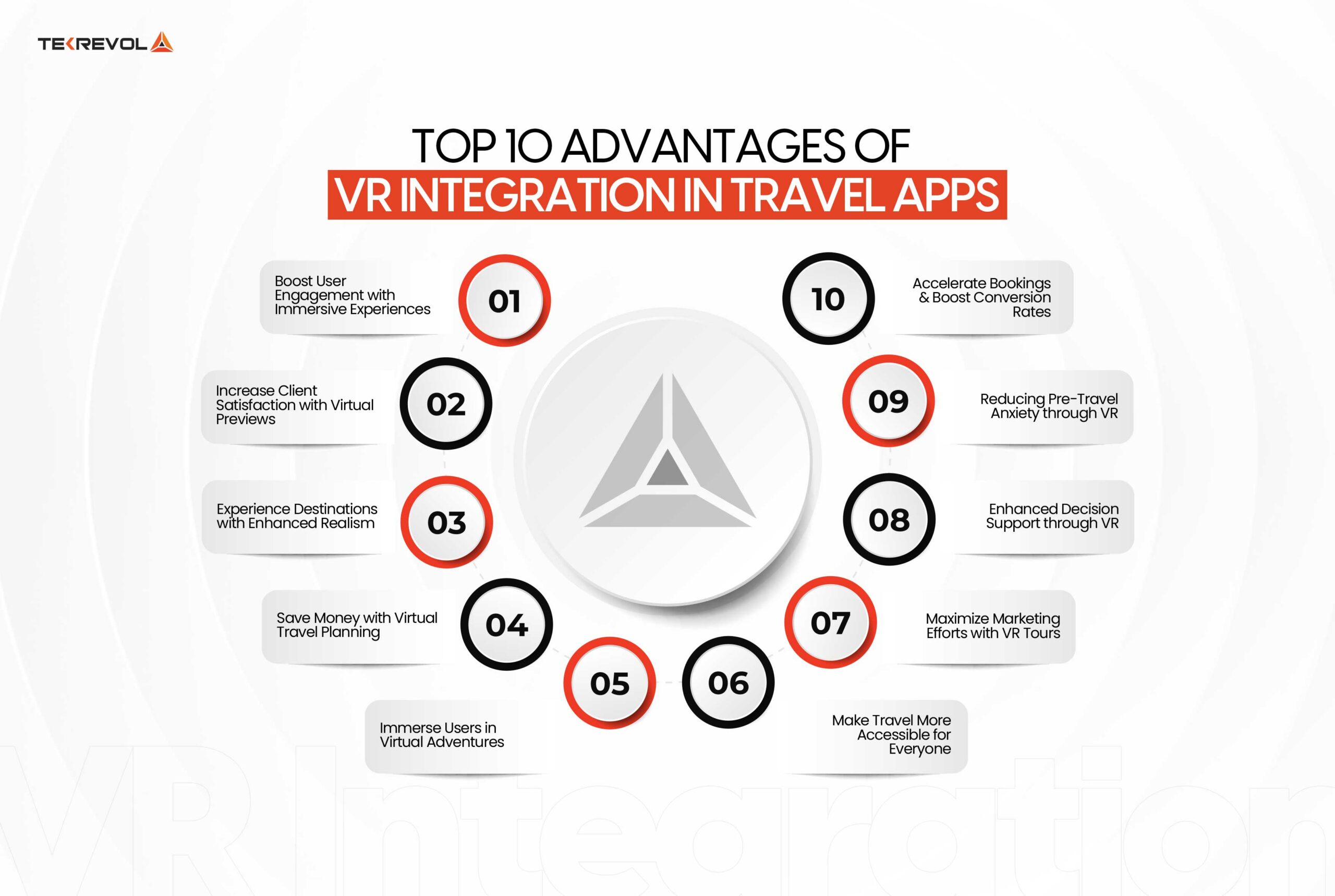 Following are a few benefits of using virtual reality in the tourism industry.
Following are a few benefits of using virtual reality in the tourism industry.
1.Boost User Engagement with Immersive Experiences
The idea of incorporating virtual reality (VR) into your travel app can work wonders in the interactivity aspect thus enhancing the user experience. Through VR, users can visit new wonderful places and attractions more engagingly than conventional tours.
You can boost user retention rates and expand your user base by enticing users to linger on your platform longer.
When users use your app to plan their travels, they are more likely to use it again and to refer it to others, which boosts the app’s visibility and improves its chances of success.
2.Increase Client Satisfaction with Virtual Previews
Customer satisfaction will rise dramatically as an outcome of giving VR experiences, which allow them to experience places before making decisions.
This helps eliminate situations in which customers are given incorrect information, increasing their satisfaction and making passengers more comfortable with their decisions.
It is also useful for giving guests a sense of the room and what the site has to offer in the surrounding area, ensuring that they are not disappointed upon arrival.
3.Experience Destinations with Enhanced Realism
VR provides a considerably more realistic experience than regular photographs or videos. It allows users to virtually move and explore a location as if they were physically present.
This brings out the reality, allowing passengers to feel more connected to the areas they want to visit, as well as increasing the enjoyment of trip planning.
Virtual tours are far more successful than seeing images since they give the impression that you are actually walking around the city, visiting monuments, and feeling the spirit of the location.
4.Save Money with Virtual Travel Planning
By allowing clients to digitally explore areas, VR decreases the need for experimental journeys, saving time and money. Travel companies can also profit from lower customer service expenses because full virtual tours include all necessary information within the app. This can simplify the travel planning process, lowering the burden on customer service teams and allowing resources to be allocated more efficiently.
5.Immerse Users in Virtual Adventures
VR is one of the most effective technologies for immersing the audience in incredibly realistic travel experiences. This high degree of involvement allows consumers to better understand the place and, as a result, improves their vacation plans.
The simplicity of testing out a location as a resident before visiting there for the real deal also improves the vacation experience.
6.Make Travel More Accessible for Everyone
Virtual reality has the potential to enhance accessibility for people with disabilities or mobility issues during travel. Realistic virtual tours enable users to plan and explore their travels without being physically limited, resulting in a more flawless and inclusive travel experience.
This digital transformation technology allows tourists to assess the accessibility characteristics of destinations and accommodations, making it easier to plan trips that cater to specific needs.
7.Maximize Marketing Efforts with VR Tours
Using virtual reality in your marketing plan can help your travel app stand out from the crowd. With fascinating and memorable virtual tours, high-quality VR material may be used in social media marketing and promotional efforts to draw in more potential customers and increase brand visibility.
Through the use of immersion-based destination marketing, your app may pique users’ interest and promote engagement, which can increase bookings and revenue. This strategy not only increases user engagement but also propels business expansion, positioning your travel app as the preferred choice for tourists looking for immersive and one-of-a-kind planning experiences.
8.Enhanced Decision Support through VR
Tour companies may employ virtual reality (VR) to take travelers virtually to a variety of locations, like swimming in the Maldives or going on wilderness safaris in Kenya.
With the use of modern technology, tourists virtually visit nearby attractions and distinctive lodging options, such as lavish tents. These virtual tours enhance anticipation for future travel by presenting the precise possibilities available at a place, helping to improve decision-making.
9.Reducing Pre-Travel Anxiety through VR
Virtual reality can significantly reduce pre-travel anxiety, especially for those who may avoid unfamiliar environments, such as cruises. Some cruise lines can virtually show their vessels and amenities, like water slides, to help passengers who have never traveled with them before have an idea of what to expect.
Additionally, VR tours of stunning locations and fascinating foreign locations that the passengers may visit on the voyage can encourage the passengers to make their cabin reservations safely and securely.
10.Accelerate Bookings & Boost Conversion Rates
With Virtual Reality (VR), travel agents may swiftly flip between evaluating several destinations, saving them a significant amount of time while dealing with consumer queries.
Previous research suggests that by offering a customized experience that meets the client’s demands, VR can assist consolidators speed up the booking process and increasing the conversion rate of potential consumers to actual clients.
Those with AR/VR experiences, on the other hand, have been demonstrated to convert clients up to 94% more effectively than those without virtual experiences.
4 Major VR Applications in the Travel Industry
By providing travelers with thorough information about travel destinations, accommodations, and cultural attractions through immersive and interactive experiences, virtual reality (VR) applications improve the process of organizing travel.
Note: If you want to create a VR app for Android, you should work with a reputable Android app development agency. Similarly, if you want to create an iOS VR app, you should work with a top-notch iOS app development agency to ensure a high-quality and flawless user experience.
1. Virtual Tours
360-degree interactive views of locations, lodging options, and landmarks are provided by virtual tours. They enable potential visitors to thoroughly investigate places before deciding which ones to reserve. These tours offer a thorough overview of the trip experience and are often equipped with audio guides, navigational controls, and pop-ups with extensive information.
Benefits:
1.Assists travelers in their location exploration and selection.
2.By highlighting properties and attractions, improves marketing efforts.
3.Lowers ambiguity and boosts confidence in reservations.
Examples:
1.Google Earth VR allows users to explore the planet in 3D.
2.Marriott’s VR Postcards showcase interactive travel stories from around the world.
2. Travel Planning and Booking
Allowing users to virtually see potential destinations and accommodations through the integration of VR experiences with travel planning and booking systems can facilitate the booking process and help passengers make better-informed decisions.
Benefits:
1.Offers immersive previews, boosting decision-making confidence over vacation.
2.Enhances user experience on booking platforms.
3.Ability to incorporate virtual tours of the hotel rooms, features, and environs.
Example:
Amadeus’ VR Booking Experience: Increases user engagement by providing a virtual reality interface for travel planning and booking.
3. Cultural and Historical Immersion
Virtual reality technology allows visitors to virtually explore historical and cultural locations. CR Interactive features bring history and culture to life, instructional materials, and guided tours are a few examples of these experiences.
Benefits:
1.Improves pre-trip planning by offering in-depth insights into places.
2.Educates and engages passengers with rich historical and cultural material.
3.Suitable for teaching history and culture in educational contexts.
Examples:
1.Google Arts & Culture: Offers realistic tours of historical and cultural sites across the globe.
2.The British Museum’s VR Tours: Provides virtual access to the museum’s collections.
4. VR Travel Experiences
People can “visit” many places without ever leaving their houses because of virtual reality travel experiences. These encounters can be incredibly lifelike and captivating, offering a feeling of presence and discovery.
Benefits:
1.Provides an option for individuals who are unable to travel because of a variety of limitations.
2.Lets people experience travel without the requirement for actual travel.
3.Also used as a marketing tool to promote tourism locations.
Examples:
1.National Geographic VR: Provides immersive experiences in a range of cultural and natural environments.
2.Ascape VR: Offers a variety of virtual travel experiences, such as nature exploration and city tours.
How TekRevol Helps You With VR Mobile App Development?
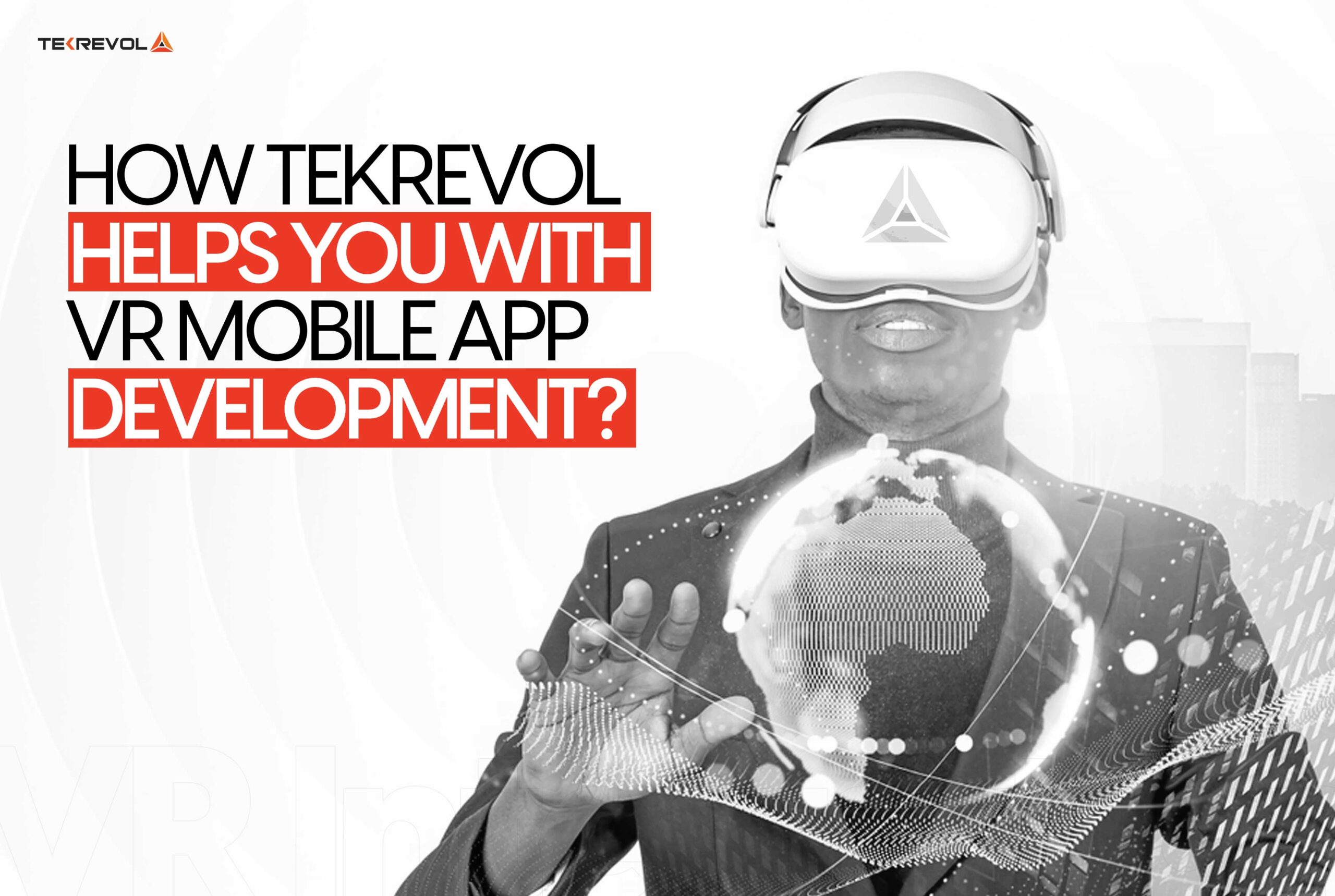
TekRevol provides a methodological and all-inclusive approach to VR software development, guaranteeing that your project is carried out expertly and precisely. Here’s how we support you during the whole procedure:
1. Consultation Call
First, TekRevol’s specialists will conduct a thorough consultation call with you to better understand your goals and vision for the VR mobile app. Whether you require an iOS VR app or an Android VR app, the first discussion matters most as it lays the groundwork for the project.
During this call, we learn about your goals, target audience, and special needs. This step helps to match our services with your expectations and ensures that the project is suited to your specific requirements.
2. Project Evaluation
We carry out a comprehensive project review following the consultation. This entails reviewing the requirements that have been gathered and determining the project’s technical viability. Our group of professionals examines the extent, possible difficulties, user experience (UX) design, and required resources.
By ensuring that every facet of the project is thoroughly thought out, this step enables us to offer precise development ideas and plans. This thorough study lays the groundwork for a successful project with careful planning.
3. Quotation & Architectural Blueprinting
After the project evaluation process, it is time to create a thorough quotation and architectural blueprint for the VR mobile app. The quotation provided allows you to easily comprehend the many charges that you will experience, making financial planning clear.
At the same time, our app developers hammer out the application’s architectural plan to get a clear picture of how it will look and perform. It gives all stakeholders a clear idea of the project’s structure and flow, which helps them grasp the development process.
- Do you want to find out the VR App Development Cost?
- Use our app development cost calculator for a more precise figure!
4. Final Proposal
The final step is to compile all of the results, strategies, and plans made in the previous stages into a single report in the form of a proposal. The final recommendation is a full written proposal that includes consultation results, project evaluation, expected expenditures, and architectural blueprints.
It outlines the processes that should be done when developing the VR smartphone app. This proposal provides you with all of the information you need to make decisions, as well as assurance that the project will be completed successfully.
- Want to Bring Your VR App Idea to Life?
- Take the first step towards turning your concept into reality.
The Bottom Line
By adopting virtual reality travel experiences, travel companies can expand their offerings, reach new markets, and accelerate business growth.
By developing virtual tours of their hotels, resorts, or other attractions, you enable prospective clients to virtually explore your offerings and establish a deeper connection with them. This can greatly enhance your app marketing efforts, attract new business, and increase booking rates.
Making a distinctive and captivating platform in this manner can help you differentiate yourself from the competitors.
Don’t just stick to the conventional and try to get a hold of an expert professional VR development agency. If you do so, you have a bright chance to deliver the ultimate experience for iOS and Android users exploring the world!

 3060 Views
3060 Views July 16, 2024
July 16, 2024